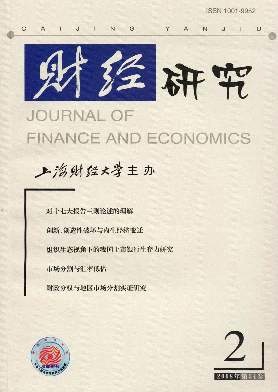文章以我国上市公司2003-2005年的数据为样本,检验了控股股东所有权、双向资金占用和盈余质量之间的关系。研究发现,控股股东所有权与应计项目之间存在倒"N"型曲线关系;在控股股东持股较少时,控股股东通过占用上市公司资金降低了盈余质量,与所有权防御效应一致;当控股股东持股较多时,控股股东所有权与盈余质量之间呈现不显著的正相关。文章认为,如果控股股东通过双向资金占用影响盈余质量,那么盈余质量是低的;如果控股股东没有通过双向资金占用影响盈余质量,双向资金占用行为本身也会降低盈余质量。文章最后提出政策建议。
控股股东所有权、双向资金占用与盈余质量
财经研究 2008 年 第 34 卷第 02 期, 页码:110 - 121
摘要
参考文献
[5]本文涉猎到的发现三次曲线关系的文献有三篇,见参考文献[5]、[7]和[9]。但这三篇文章的因变量都是企业价值(业绩)。
[1]洪剑峭,方军雄.关联交易和会计盈余的价值相关性[J].中国会计评论,2005,3(1):87-98.
[2]姜国华,岳衡.大股东占用上市公司资金与上市公司股票回报率关系的研究[J].管理世界,2005,(9):120-123.
[3]李增泉,孙铮,王志伟.“掏空”与所有权安排——来自我国上市公司大股东资金占用的经验证据[J].会计研究,2004,(12):3-12.
[4]李增泉,余谦,王晓.掏空、支持与并购重组——来自我国上市公司的经验证据[J].经济研究,2005,(1):95-104.
[5]王化成,佟岩.控股股东与盈余质量——基于盈余反应系数的考察[J].会计研究,2006,(2):66-73.
[6]谢军.第一大股东持股和公司价值:激励效应和防御效应[J].南开管理评论,2007,(1):21-31.
[7]张继袖,陆宇建.控股股东、政府补助和盈余质量[J].财经问题研究,2007,(4):41-47.
[8]郑国坚,魏明海,孔东民.大股东的内部市场与上市公司价值的N型关系——基于效率观点与掏空观点的实证检验[EB/OL],2007-09-08.
[9]Bertrand M,Mehta P,Mullainathan S.Ferreting out tunneling:An application toindi-an business groups[J].The Quarterly Journal of Economics,2002,(117):121-148.
[10]Chao Chen,Song Zhu.Ulti mate shareholder,government control,and firmperformance in China[EB/OL].http://ccfr.org.cn,2006-06-18.
[11]Claessens S,Djankov S,Joseph Fan,et al.Disentangling the incentive and entrenchment effects of large shareholding[J].The Journal of Finance,2002,57:2741-2771.
[12]DeChun Wang.Founding family ownership and earnings quality[J].Journal of Ac-counting Research,2006,44(3):619-656.
[13]Friedman E,Johnson S,Mittton T.Propping and tunneling[J].Journal of Compara-tive Economics,2003,31:732-750.
[14]Johnson S,R La Porta,F Lopez-De-Silanes,et al.Tunneling[J].American Economic Review,2000,90:22-27.
[15]Joseph Fan,TJ Wong.Corporate ownership structure and theinformativeness of accounting earnings in East Asia[J].Journal of Accounting and Economics,2000,(3):401-425.
[16]Morck R B,Yeung W Yu.The information content of stock markets:Why do emer-ging markets have synchronous stock price movements[J].Journal of Financial Eco-nomics,2000,58:215-260.
[17]Shleifer A,Wolfenzon D.Investor protection and equity markets[J].Journal of Finan-cial Economics,2002,66:3-27.
[1]洪剑峭,方军雄.关联交易和会计盈余的价值相关性[J].中国会计评论,2005,3(1):87-98.
[2]姜国华,岳衡.大股东占用上市公司资金与上市公司股票回报率关系的研究[J].管理世界,2005,(9):120-123.
[3]李增泉,孙铮,王志伟.“掏空”与所有权安排——来自我国上市公司大股东资金占用的经验证据[J].会计研究,2004,(12):3-12.
[4]李增泉,余谦,王晓.掏空、支持与并购重组——来自我国上市公司的经验证据[J].经济研究,2005,(1):95-104.
[5]王化成,佟岩.控股股东与盈余质量——基于盈余反应系数的考察[J].会计研究,2006,(2):66-73.
[6]谢军.第一大股东持股和公司价值:激励效应和防御效应[J].南开管理评论,2007,(1):21-31.
[7]张继袖,陆宇建.控股股东、政府补助和盈余质量[J].财经问题研究,2007,(4):41-47.
[8]郑国坚,魏明海,孔东民.大股东的内部市场与上市公司价值的N型关系——基于效率观点与掏空观点的实证检验[EB/OL],2007-09-08.
[9]Bertrand M,Mehta P,Mullainathan S.Ferreting out tunneling:An application toindi-an business groups[J].The Quarterly Journal of Economics,2002,(117):121-148.
[10]Chao Chen,Song Zhu.Ulti mate shareholder,government control,and firmperformance in China[EB/OL].http://ccfr.org.cn,2006-06-18.
[11]Claessens S,Djankov S,Joseph Fan,et al.Disentangling the incentive and entrenchment effects of large shareholding[J].The Journal of Finance,2002,57:2741-2771.
[12]DeChun Wang.Founding family ownership and earnings quality[J].Journal of Ac-counting Research,2006,44(3):619-656.
[13]Friedman E,Johnson S,Mittton T.Propping and tunneling[J].Journal of Compara-tive Economics,2003,31:732-750.
[14]Johnson S,R La Porta,F Lopez-De-Silanes,et al.Tunneling[J].American Economic Review,2000,90:22-27.
[15]Joseph Fan,TJ Wong.Corporate ownership structure and theinformativeness of accounting earnings in East Asia[J].Journal of Accounting and Economics,2000,(3):401-425.
[16]Morck R B,Yeung W Yu.The information content of stock markets:Why do emer-ging markets have synchronous stock price movements[J].Journal of Financial Eco-nomics,2000,58:215-260.
[17]Shleifer A,Wolfenzon D.Investor protection and equity markets[J].Journal of Finan-cial Economics,2002,66:3-27.
引用本文
周晓苏, 张继袖, 唐洋. 控股股东所有权、双向资金占用与盈余质量[J]. 财经研究, 2008, 34(2): 110–121.
导出参考文献,格式为:





 6985
6985  4217
4217

